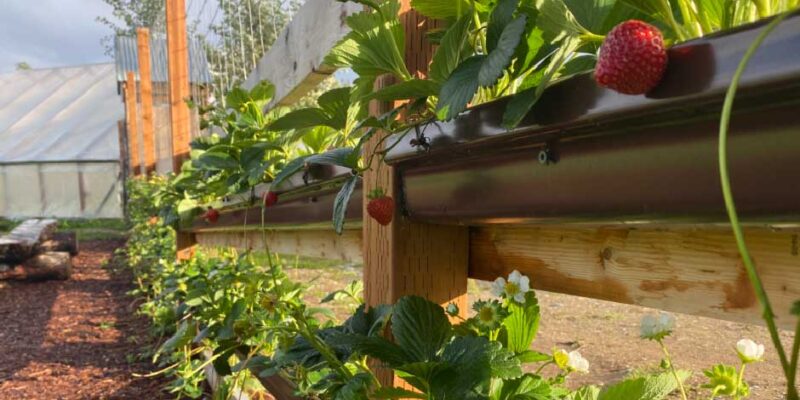There’s nothing quite like the taste of homegrown fruit, plucked fresh from your garden. Raspberries, strawberries, and fruit trees like apples or cherries can transform your backyard into a haven of delicious, nutrient-rich produce. Growing these plants together allows you to enjoy a variety of flavors while making the most of your garden space. This guide shares expert tips to help you maximize both the flavor and yield of your raspberry plants, raspberry plants, and fruit trees, ensuring a bountiful and tasty harvest.
The Joy of Growing Your Own Fruit
Cultivating raspberries, strawberries, and fruit trees offers more than just fresh produce—it’s a chance to connect with nature and savor the fruits of your labor. Raspberries bring a tart-sweet zing, perfect for jams or fresh eating. Strawberries offer juicy sweetness, ideal for desserts or smoothies. fruit trees provide crisp, flavorful harvests that can last for years. By focusing on proper planting, care, and harvesting techniques, you can enhance the taste and quantity of your garden’s output.
Optimizing Raspberry Plants for Flavor and Yield
Raspberries are a versatile addition to any garden, delivering vibrant flavor with relatively simple care. To maximize their potential, choose between summer-bearing varieties, which produce one large crop, or everbearing types, which yield fruit in both summer and fall for extended harvests.
Select a sunny location with well-drained, slightly acidic soil (pH 5.5–6.5). Before planting, enrich the soil with compost or well-rotted manure to boost nutrient levels. Space raspberry canes 2–3 feet apart in rows and provide a trellis or stakes to support their growth. Water consistently, aiming for about an inch of water per week, and mulch with straw or wood chips to retain moisture and deter weeds.
To enhance flavor, avoid overwatering, as excess moisture can dilute the berries’ taste. Prune regularly to increase yields: for summer-bearing raspberries, cut back canes that have fruited; for everbearing varieties, prune all canes to the ground in late winter. This promotes vigorous new growth and prevents disease. Harvest raspberries when they’re fully colored and slip off the cane easily—these will be the sweetest and most flavorful.
Boosting Strawberry Plants for Sweet, Plentiful Berries
Strawberries are a garden favorite, known for their rich flavor and versatility. To maximize both yield and taste, choose from June-bearing (one large crop), everbearing (multiple smaller crops), or day-neutral (continuous fruiting) varieties, depending on your harvest goals.
Plant strawberries in early spring in a sunny spot with well-drained soil, ideally with a pH of 5.5–6.5. Mix in compost or organic matter to enrich the soil, and space plants 12–18 inches apart. Place the crown just above the soil line to prevent rot. Mulch with straw or pine needles to keep the soil cool, retain moisture, and reduce weeds. Water evenly, providing about an inch per week, and avoid wetting the leaves to prevent fungal issues.
For sweeter berries, pinch off the first flowers in the plant’s first year to encourage stronger roots, which leads to better fruit quality. Remove runners unless you’re propagating new plants, as they divert energy from fruit production. Harvest strawberries when they’re fully red and slightly soft, as this ensures peak sweetness. Regular soil testing and amendments, like adding potassium-rich fertilizers, can further enhance flavor.
Maximizing Fruit Trees for Abundant, Tasty Harvests
Fruit trees are a long-term investment that can yield exceptional fruit with proper care. Choose varieties suited to your climate, such as apple, pear, plum, or cherry trees. Dwarf or semi-dwarf trees are ideal for smaller gardens, as they produce fruit sooner and are easier to maintain.
Plant fruit trees in early spring or fall in a sunny, well-drained location. Dig a hole twice as wide as the root ball, mixing in compost to improve soil fertility. Water deeply after planting and apply a 2–3-inch layer of mulch around the base, keeping it away from the trunk to prevent rot. Most fruit trees need a second tree for cross-pollination, so plant compatible varieties or select self-pollinating options.
To boost flavor and yield, prune annually in late winter to remove dead or crossing branches and open the canopy for better sunlight penetration. This encourages larger, tastier fruit. Water young trees weekly, especially during dry spells, and fertilize in early spring with a balanced fertilizer. Thin fruit in early summer, removing smaller or crowded fruits to allow the remaining ones to grow larger and more flavorful.
Creating a Synergistic Garden for Maximum Results
To maximize flavor and yield, design your garden to support all three plants. Group raspberries and strawberries in a shared bed with similar soil and sunlight needs, while placing fruit trees in a separate area with deeper soil. Ensure trees don’t shade smaller plants by positioning them on the north side of your garden.
Incorporate companion plants like marigolds or dill to attract pollinators and repel pests, improving fruit set and reducing damage. Maintain healthy soil by adding organic matter annually and testing pH regularly. Use drip irrigation or soaker hoses to deliver consistent moisture, as uneven watering can stress plants and affect fruit quality.
Choose a mix of early-, mid-, and late-season varieties to extend your harvest. For example, combine early June-bearing strawberries, everbearing raspberries, and late-season apple trees for fruit from spring through fall. This diversity ensures a steady supply of fresh produce and maximizes your garden’s output.
Protecting Your Plants for Better Yields
Pests and diseases can reduce both flavor and yield, so proactive protection is key. Use netting to shield raspberries and strawberries from birds, and apply organic treatments like neem oil for insects like aphids or spider mites. For fruit trees, sticky traps or pheromone traps can help manage pests like codling moths.
Monitor plants regularly for signs of disease, such as powdery mildew on raspberries or leaf spot on strawberries. Remove affected leaves promptly and improve air circulation through pruning. For fruit trees, watch for issues like fire blight or fungal infections, and treat early with organic solutions.
Harvesting and Savoring the Fruits of Your Labor
Harvest raspberries when they’re fully colored and detach easily, as this ensures peak flavor. Pick strawberries when they’re bright red and slightly soft for maximum sweetness. For fruit trees, harvest when fruit is firm but yields to gentle pressure, tasting a few to confirm ripeness.
To preserve flavor, store berries in the refrigerator for up to a week or freeze them for longer use. Fruit from trees can be eaten fresh, canned, or turned into preserves, pies, or sauces. Experiment with recipes like raspberry jam, strawberry smoothies, or apple tarts to showcase your garden’s bounty.
Building a Flavorful, Productive Garden
Growing raspberries, strawberries, and fruit trees together creates a garden that’s both productive and delightful. By focusing on soil health, proper care, and strategic planting, you can maximize the flavor and yield of your harvests. Start with a small setup, learn as you go, and expand your garden as your skills grow.
Your garden will reward you with fresh, delicious fruit that elevates every meal. Whether you’re enjoying a handful of sun-ripened berries or baking with tree-fresh apples, the effort you put into your garden will pay off in every bite. Begin today, and let your backyard become a source of abundant, flavorful fruit.

















